
Choosing the right road bike frame size is vital for a proper fit, comfort, and performance. This guide helps you understand the importance of frame size and how to select the best fit for your needs, ensuring an optimal riding experience.
Why Frame Size Matters for Comfort and Performance
Proper frame size is crucial for ensuring comfort, efficiency, and control while riding. A bike that is too small or too large can lead to discomfort, poor posture, and even pain during long rides. The right frame size allows for optimal body positioning, reducing strain on the neck, back, and hands. It also maximizes pedaling efficiency and power transfer, enabling better performance. A well-fitting frame improves handling and stability, making the bike easier to maneuver. Ultimately, the correct size enhances the overall riding experience, ensuring both enjoyment and safety on the road.
Key Considerations for Choosing the Right Frame Size
Height, inseam, riding style, and frame geometry are essential factors. Consult size charts, test ride bikes, and consider manufacturer variations to ensure the best fit for your needs.
Height and Inseam: The Primary Measurements
Height and inseam are the cornerstone measurements for determining the right road bike frame size. Your height helps narrow down the frame size range, while inseam, measured from the floor to the crotch with cycling shoes on, ensures proper standover clearance. For accurate results, stand against a wall with a book or ruler pressed against your groin to simulate a saddle. Most size charts correlate height with frame size, but inseam can vary independently. A taller rider might need a larger frame, while a shorter inseam might require adjustments. These measurements are crucial but should be combined with other factors like riding style and geometry for the best fit. Always consult a size chart and test ride if possible to confirm.
Riding Style and Its Impact on Frame Size

Riding style significantly influences road bike frame size selection, as it affects comfort, efficiency, and control. Aggressive riders prioritizing speed and aerodynamics may prefer a smaller frame for better handling, while endurance or recreational riders often opt for a slightly larger frame to reduce strain on the back and neck. A more upright riding position, common in comfort-focused styles, may require a taller head tube, whereas a race-oriented setup demands a lower, more stretched posture. Riders should consider whether they favor stability and comfort or speed and agility. This, combined with height and inseam, helps refine the ideal frame size, ensuring a balance between performance and comfort tailored to their cycling goals and preferences.

Understanding Road Bike Frame Size Charts
Road bike frame size charts provide a guide based on height and inseam to help determine the ideal frame size. While not a perfect system, they offer a useful starting point for selecting a bike that fits your body proportions and riding style, ensuring comfort and efficiency on the road.
How to Read and Interpret Frame Size Charts
Frame size charts typically correlate your height and inseam to suggested frame sizes. Start by measuring your height and inseam accurately, then match these to the chart’s guidelines. Note that charts may vary by manufacturer due to differences in frame geometry. Pay attention to the size range and corresponding rider height to narrow down your options. While charts provide a useful starting point, they aren’t foolproof. Personal fit preferences, such as reach and comfort, may require adjustments. Always consider test riding a bike to ensure the best fit, as sizing can vary between brands and models. This step ensures optimal comfort and performance for your riding style.
Manufacturer Variations in Sizing
Manufacturer variations in sizing can significantly impact your frame size selection. Different brands often use unique sizing standards, with some using centimeters and others inches. This lack of universal sizing means a 52cm frame from one brand may not match another’s. Additionally, frame geometry differences, such as wheelbase or head tube length, can affect fit. Some manufacturers prioritize aerodynamics, while others focus on comfort or performance. Always consult the specific brand’s size chart, as even similar nominal sizes can vary. Test riding is crucial to ensure the best fit, as sizing inconsistencies can lead to discomfort or poor performance. This variability underscores the importance of thorough research and hands-on testing.
Measuring Yourself for the Perfect Fit
Accurate self-measurement is key to finding your ideal road bike frame size. Stand over the bike, measure your inseam, and ensure proper clearance. Use a flexible tape measure or seek assistance for precise results.
Step-by-Step Guide to Accurate Measurements
To ensure a perfect fit, follow these steps for accurate measurements:
- Measure your height in inches or centimeters while standing barefoot.
- Measure your inseam by standing over a book or ruler with cycling shoes on.
- Stand over the bike with feet shoulder-width apart to check standover clearance.
- Use a flexible tape measure to record arm reach and torso length.
- Compare measurements to a road bike size chart or consult a professional fitter.
These steps ensure precise measurements for selecting the right frame size, optimizing comfort and performance.

Frame Geometry and Its Role in Size Selection
Frame geometry significantly impacts bike fit, comfort, and performance. It determines handling, stability, and riding position, making it crucial to consider when selecting the right frame size.
Understanding Different Frame Geometries
Frame geometry plays a crucial role in determining a bike’s comfort, performance, and handling. It refers to the measurements and angles of the bike’s frame, such as wheelbase, seat tube angle, and head tube angle. These elements influence how the bike responds to rider input and how it fits the rider’s body. For example, a longer wheelbase can improve stability, while a steeper head tube angle enhances maneuverability; Different geometries cater to various riding styles, such as endurance, racing, or gravel riding. Understanding these variations helps riders choose a frame that aligns with their preferences and riding goals, ensuring optimal performance and comfort on the road.

Test Riding and Adjustments
Test riding a bike allows you to assess fit, comfort, and performance in real conditions. Adjustments like saddle height, handlebar position, and cleat alignment can fine-tune your setup for optimal riding efficiency and comfort.
How to Test Ride a Bike for the Best Fit
Test riding a bike is essential to ensure a proper fit and optimal performance. Start by checking the saddle height, ensuring a slight bend in your knee when the pedal is at its lowest point. Wear cycling shoes to assess cleat alignment and comfort. Take the bike on a variety of terrain, including climbs and descents, to gauge handling and stability. Pay attention to how the bike feels—does it respond naturally to your movements? Are you comfortable in both seated and standing positions? Adjust the handlebar height and stem length if needed to achieve a balanced riding position. A test ride should reveal any issues with sizing or geometry, helping you make the right choice for your riding style and preferences.
Common Mistakes to Avoid
Avoid common errors like relying solely on height, ignoring inseam, or not considering riding style. Overlooking frame geometry and failing to test ride can lead to poor fit and discomfort.
Pitfalls in Frame Size Selection
One of the most common mistakes is relying solely on height without considering inseam or riding style. Ignoring frame geometry can lead to a poor fit, affecting comfort and performance. Many riders overlook manufacturer sizing variations, assuming universality across brands. Additionally, some prioritize style over functionality, compromising ergonomics. Failing to test ride a bike before purchase is another costly oversight, as it prevents assessing how the frame feels in real conditions. Lastly, neglecting professional bike fits or relying on outdated size charts can result in suboptimal sizing. These pitfalls highlight the importance of a holistic approach to frame size selection for the best riding experience.